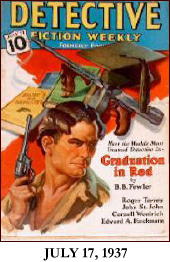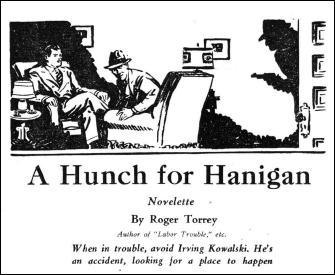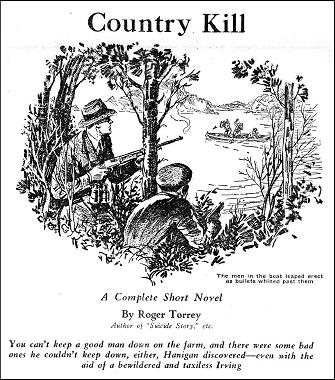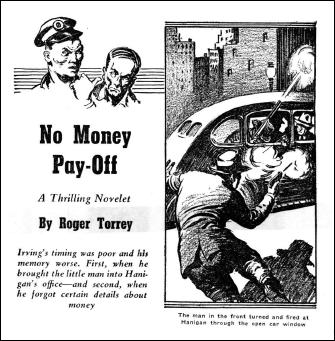Wed 1 Aug 2012
Characters from DFW #14: HANIGAN & IRVING — by Monte Herridge.
Posted by Steve under Bibliographies, Lists & Checklists , Characters , Columns , Pulp Fiction[14] Comments
DETECTIVE FICTION WEEKLY
by Monte Herridge
#14. HANIGAN & IRVING, by Roger Torrey.
The Hanigan & Irving stories by Roger Torrey were a short series of eleven stories published in Detective Fiction Weekly from 1937 to 1941. There are two main characters in the series and a number of supporting ones. The main characters are private detective Michael “Mickey†Hanigan and his assistant – Irving Koslowski the taxi driver.
Hanigan is a former cop, probably a detective, before he opened up his agency. “Hanigan had ethics, though of a peculiar sort and often discounted by the police department.†(Suicide Story) Irving usually drives a decrepit old taxi and takes Hanigan wherever he needs to go and also assists when needed. Irving’s last name was Borowski in “The Meter Says Murder†but changes to Koslowski later in the series. (see “Murder Tips the Scales†from 1940)
Supporting characters include Nancy Evans, Hanigan’s girl friend, always ready to try to convince Hanigan to take the day off and relax. But Hanigan usually resists the temptation, insisting that he needs to be in his office in case someone needs him. She tried to help him in the first story in the series, but wound up making a mess of matters, so she refrains from helping him after that unless he asks her.

Various police detectives are also supporting characters in the stories, but they are different in each story.
Irving is introduced in the first story in the series, “Case for a Killer†(DFW, September 17, 1937), and is of assistance to Hanigan in the story. Hanigan just picks his taxi at random, and does not identify Irving by name in his first scene. In a later scene, after Hanigan repeatedly calls him Jack, Irving corrects him and tells him his name.
He also tells Hanigan: “You’re the kind of a guy I like; one that makes up his mind.†Before the two go to a Greek bar, Hanigan tells Irving: “To this Greek spot, and you’re to go in with me. If there’s any dough in this, I’ll see you’re taken care of. If not, you got a steady customer at least.†So it was by sheer accident that the two met up and Irving became hired by Hanigan for future jobs.
In another story (The Meter Says Murder) Hanigan defends his hiring of Irving: “Now about Irving. The guy ain’t making any money hacking and all I’ve got to pay him is enough for him to get along. And the cab’s handy and he’s a handy boy.†Later Hanigan seems to regret his hiring of Irving, for it was said about him: “Irving Kowalski, who drove a taxi part time and who drove Hanigan to desperation practically the remainder of the time. . .†(Suicide Story)
Irving’s description was given in “Suicide Storyâ€: “Irving wasn’t tall but he was built like a Shetland pony. Stocky. There’d been several times when he hadn’t ducked in the right direction and these errors in judgment had given him a slightly lumpy appearance. One ear had been torn and this hung at a slight angle, and the gold teeth he’d chosen to replace originals knocked out by knuckles, shone at Hanigan out of the murk.â€
In the first story in the series, “Case for a Killerâ€, the story is longer than later stories. It is described as a short novel, and the other stories in the series are novelettes. Hanigan is hired to bodyguard Nick Poulas and his young daughter for four days until they sail on a ship for overseas.
Unfortunately, an assassin breaks into the hotel room while Poulas is giving his story to Hanigan and shoots Poulas with a shotgun. Hanigan takes this hard, and promptly shots the assassin while he is trying to escape. He hides the daughter from the police and goes out on an investigation. Poulas had a valuable briefcase that is missing, so Hanigan searches for that too.
There is a big conflict between the police and Hanigan and Irving on one side, and two group of crooks on the other. Irving did a good job helping, and the police captain said about him: “Well, he’s a bearcat.†Hanigan replied: “He’s my boy. He’s going to work for me.†So that incident tied up the connection between Hanigan and Irving.
In the second story, “The Meter Says Murderâ€, Hanigan is in trouble over a murder. He had had an argument with a newspaper journalist, whom he threatened. The journalist shows up dead the next day in Irving’s taxicab, and both Hanigan and Irving wind up down at the police station trying to explain the situation to one of the Homicide detectives. Hanigan then sets out to investigate the case and clear his name.
“You Only Hang Once†starts off with Hanigan being called upon to bail Irving out of jail. Irving has a number of charges against him, which he says he is not guilty of committing. The person putting the charges against Irving winds up murdered the next day, and Hanigan gets involved when an heir to a hefty sum is accused of the crime.
Irving is attacked and both stabbed and slugged, and Hanigan is also attacked when he finds a seriously injured Irving in his taxi. It doesn’t take long for Hanigan to clear up the cases, which are all connected, once he gets a bit of cooperation from friends in the police department.
“A Hunch for Hanigan†finds Hanigan searching for and finding a missing heiress. The case becomes complicated when the heiress is mysteriously killed in an automobile accident with a train. Both the police (in the person of Detective-Lieutenant Simpson) and Hanigan find the accident suspicious.

The woman’s husband, who happens to be the number one suspect in the death, asks Hanigan to investigate the crime and find the murderer. In this story, Hanigan works well with Detective-Lieutenant Simpson.
“Suicide Story†starts off quickly, with a woman entering Hanigan’s detective agency office and attempting to shoot him. He disarms her and has her tell him why she shot at him. Her boyfriend committed suicide, she said, because Hanigan was investigating his firm.
Hanigan promises to look into the matter and goes to the seedy hotel where the man had been staying. What he finds convinces him that it is murder, not suicide, and he decides to check further into the case.
In “Country Kill†Hanigan is called to the country for a case by a landowner who is being sniped by an unseen rifleman. The shooter doesn’t seem to want to hit anyone, just cause a nuisance. His client is an unpopular person in the neighborhood, making matters more difficult.

The case becomes more complicated when not only is a murder committed, but also three city gunmen decide to come to the area supposedly for fishing on the local lake. Hanigan calls Irving to come down to help him, and leave his taxi behind. Irving doesn’t like being separated from his taxi.
“A Bodyguard for Beano†starts off with Hanigan being hired to bodyguard the rich owner’s prize pedigreed English bulldog, and then moves on the real motive for the hiring. Joseph T. Collins, the dog owner, has really hired Hanigan to bodyguard him. He is in fear of his life from his other three partners in his business firm.
One attempt on his life took place on the first day Hanigan arrived at Collins’ house and before Collins told him why he was there.
“No Money Payoff†starts with Irving bringing in a tipster to Hanigan’s office. The tipster claims he knows about a jewelry theft worth ninety thousand dollars that the insurance company would pay to know about. Hanigan, with a hangover from the night before, doesn’t believe him and throws the guy out.

Irving is convinced the guy is telling the truth, and follows him, only to run into the middle of the kidnapping of the tipster by two crooks. Irving is shot, and winds up in the hospital. He tells Hanigan the story, and Hanigan finds out there actually was a jewelry heist that the tipster could know about. Then he is interested in tracking down the tipster and finding the jewels in order to get the insurance company fee.
This is probably the most violent of the stories in the series. Five men are killed (one a policeman) and two are seriously hurt. Only Hanigan’s good detective instincts and experience keep him safe from harm.
In “Murder Tips the Scales†Hanigan and Irving become involved in a plot to kill some ex-politicians. The first politician asks for Hanigan’s help but is killed before Hanigan can do anything or find out any more information than a threatening note stating that three will be killed.
As usual, Irving convoys Hanigan around in his taxi, but he does get in on some of the action. Irving chases a suspect in a scene, but somewhat ineptly. He buys another taxi, but it keeps breaking down and stranding Hanigan and Irving. The murderer turns out to be the least likely suspect.
Police Detective-Lieutenant George Woods was ready to give Hanigan a hard time about virtually anything to do with his current cases. Woods often thought that Hanigan knew some facts about his current criminal case. And Woods was right; Hanigan just didn’t want to tell Woods anything because he was working on the case. Hanigan was in it for the money.
“Frame for a Killer†opens with Hanigan and Irving unknowingly being framed for a jewelry robbery and murder in the same building that Hanigan’s new was located in. Most of the story consists of Hanigan and Irving trying to get out of the frame and get the right criminals.
First Hanigan has to escape from two policemen who have arrested both him and Irving for the crimes. A shootout with the criminals finalizes the case. Then Hanigan has to explain matters to the police, who don’t look too kindly on Hanigan for assaulting their detectives.
This is an above average series, with some good stories. There is an element of humor in the stories, often contributed by Irving’s actions. Irving is actually of some assistance in Hanigan’s cases, even with the humorous situations.
This series deserves to be reprinted. The stories are fairly long, so eleven stories might fill a book.
The Hanigan & Irving series, by Roger Torrey:
Case for a Killer July 17, 1937
The Meter Says Murder December 11, 1937
You Only Hang Once April 23, 1938
Labor Trouble September 17, 1938
A Hunch for Hanigan November 12, 1938
Suicide Story April 15, 1939
Country Kill May 27, 1939
A Bodyguard for Beano August 26, 1939
No Money Payoff December 16, 1939
Murder Tips the Scales February 24, 1940
Frame for a Killer November 1, 1941
Previously in this series:
1. SHAMUS MAGUIRE, by Stanley Day.
2. HAPPY McGONIGLE, by Paul Allenby.
3. ARTY BEELE, by Ruth & Alexander Wilson.
4. COLIN HAIG, by H. Bedford-Jones.
5. SECRET AGENT GEORGE DEVRITE, by Tom Curry.
6. BATTLE McKIM, by Edward Parrish Ware.
7. TUG NORTON by Edward Parrish Ware.
8. CANDID JONES by Richard Sale.
9. THE PATENT LEATHER KID, by Erle Stanley Gardner.
10. OSCAR VAN DUYVEN & PIERRE LEMASSE, by Robert Brennan.
11. INSPECTOR FRAYNE, by Harold de Polo.
12. INDIAN JOHN SEATTLE, by Charles Alexander.
13. HUGO OAKES, LAWYER-DETECTIVE, by J. Lane Linklater.
August 1st, 2012 at 10:26 pm
Roger Torrey is one of the unjustly forgotten hardboiled writers. His work was not of the first rank but he definitely deserves to be read along with many of the writers who were not as good as Hammett, Chandler, or even Paul Cain and Fred Nebel.
He died an early death probably because of alcoholism. Monte is right, this series would make a nice collection. Perhaps Black Dog Books or Altus Press?
August 2nd, 2012 at 12:43 am
I agree. Either publisher would do a great job with these stories as a collection. I like the fact that Monte calls the stories fairly long, so that there’s time to get some flow to them.
I wish I could say that I’ve read any of them, and I’m sure I have, but it was a long time ago, and I at the time I wouldn’t have known anything about the author or that the stories were part of a series.
We lived in the Dark Ages then (the 1970s) as far as pulp research was concerned. It was Ron Goulart and almost nobody else.
August 2nd, 2012 at 6:37 am
Your comment about the scarcity of pulp research back in the 1970’s made me think back on what I was doing. In addition to Goulart and Bob Sampson, I was subscribing to XENOPHILE for the articles and sale ads. But the big thing for me was Pulpcon in 1972.
Nothing like a big room full of pulps to encourage research. Leonard Robbins used to sit at a table the entire weekend at Pulpcon, indexing the contents pages of hundreds of pulps. He did this for many Pulpcons.
I started to make my own indexes. For instance I had my own personal index by author for DIME DETECTIVE. My friend Digges La Touche still refers to his handwritten indexes for many magazines. He even has one for the series characters in DFW. But he is strickly a reader and seldom writes.
Harry Noble and I made up many a list showing the dates of issues and the major authors in each issue. We had lists showing such information for just about all the major pulps like ADVENTURE, SHORT STORIES, BLUE BOOK, POPULAR, ALL STORY, ARGOSY, WESTERN STORY, etc. Harry’s gone but I still have mine.
August 2nd, 2012 at 9:58 am
Making more pulp fiction available as reprints (BLACK DOG, etc.) or as ebooks would create a whole new market for this material. I’d be a candidate for buying the Hanigan & Irving series by Roger Torrey in either book or ebook format. By the way, in reference to MISSION TO PARIS, you might want to check with your local public library about its availability as an ebook. My public library has thousands of ebooks I can download. My iPad has dozens of ebooks waiting to be read!
August 2nd, 2012 at 10:28 am
George’s reference to MISSION TO PARIS is to Alan Furst’s latest pre-WWII thriller that he reviewed on his blog:
http://georgekelley.org/?p=12325#comments
My comment there was that it’s hard for me to buy new hardcover books, even at a discount, when I have so many books here at home I haven’t read yet. I’m afraid that I’m too much of a collector for me to consider ebooks as an option. I need to have something tangible in my hands, that will still be there when I put it down. They’re fine for readers, but not for collectors.
As for pulp reprints, I think it’s great that are coming out in ebook formats and that people are reading them, but for example, with all of the books and pulp stories already online for free, I’ve never read one of them. Just not for me.
August 2nd, 2012 at 12:15 pm
This 20th century mug still only feels right with a *book for reading. Modern computer reading seems a bit strange.
Even the stone tablets wound up on book pages;
why challenge da Big Guy?
August 2nd, 2012 at 1:51 pm
Monte’s excellent research has saved more than one once-popular detective series from undeserved oblivion.
KUTGW, Monte.
August 2nd, 2012 at 1:56 pm
The only pulp story by Roger Torrey I have ever read is “Clean Sweep” from Black Mask. It is reprinted in “The Hard-Boiled Omnibus”, ed. by Joseph T. Shaw. The story is extremely hard-boiled, nearly a caricature. There were many crime stories by Torrey in Black Mask. I was very surprised when I began to read Torrey’s only crime novel “42 Days for Murder”, a book. It is quite different: light-hearted, funny. It should be also reprinted, and the Black Mask stories.
August 2nd, 2012 at 4:13 pm
I’ll have to find my copy of 42 DAYS. I’ve always meant to read it, and I’ve never quite found the time for it.
I did read a collection of pulp stories that Black Dog Books did a couple of years ago, THE BODYGUARD AND OTHER STORIES:
https://mysteryfile.com/blog/?p=1947
I think these were written during the downside of his career, as I found them to be a fairly mixed bunch, first published in the second or third rank of detective magazines, such as SPICY DETECTIVE and PRIVATE DETECTIVE.
A collection of his work for BLACK MASK might be even better than a book of these Hanigan & Irving stories.
August 2nd, 2012 at 6:04 pm
Steve has a point. The Black Dog Books collection reprinted stories from PRIVATE DETECTIVE and SPICY DETECTIVE, two of the lower quality detective magazines. Torrey did dozens of stories for this publisher, some good and fun to read, others obviously written in a sloppy manner.
A collection of Torrey’s work from BLACK MASK and maybe DIME DETECTIVE would give us a look at his best fiction. During the 1940’s Daisy Bacon became the editor of Street & Smith’s DETECTIVE STORY MAGAZINE. She decided to upgrade the quality and publish stories that were not so dated and old hat.
So she encouraged writers to write some hard boiled and fast moving stories. Especially in the digest years of 1943-1949 she printed work by William Campbell Gault, Fred Brown, Roger Torrey, and others. Torrey did at least a dozen novelets for Daisy, all starring Irish detectives. They were well done and certainly better than the fiction in PRIVATE DETECTIVE. These stories also would make a great book and help revive Torrey’s reputation.
August 4th, 2012 at 12:04 pm
The Roger Torrey stories were always a questionable read for me. His early hardboiled yarns in BLACK MASK are pretty good, his later work in PRIVATE DETECTIVE was fairly dismal. I have read 42 Days for Murder and it is not my taste although not badly written. His digest work I am not familiar with.
October 27th, 2012 at 4:58 pm
Torrey’s detective Shean Connell, from 42 DAYS TO MURDER, appeared in four stories in BLACK MASK and four in DETECTIVE STORY MAGAZINE. As Walker has said many times, these stories are worth checking out. Torrey had a good editor in Daisy Bacon, when most editors did not want to bother with him. The DETECTIVE STORY MAGAZINE digests won’t break your wallet compared to other titles. They would be worthy of a collection, but it would not be cost effective. The lawyer handling the rights to the stories would cost a lot, and Street & Smith cannot be bothered for that reason. I wish someone could put the Connell stories together in one collection, but it seems much too costly.
October 27th, 2012 at 10:58 pm
Joel is right about the problem with the rights to the old Street & Smith pulps. Anthony Tollin managed to get them to okay his plan to reprint the SHADOW, so he evidently has connections. But then again he has never really shown any interest in the hardboiled detectives or Torrey. Tollin’s main interest has always been connected with the SHADOW.
If you like quality hardboiled literature, then your best bet is to simply start collecting the digest DETECTIVE STORY, 1943-1949. They are inexpensive and not that hard to find. I’ve seen them at the two big pulp shows: Windy City and Pulpfest. They also show up on ebay. I’ve never been one to wait for someone to reprint my favorite literature. It’s a pulp jungle out there but the magazines await us!
October 28th, 2012 at 12:25 pm
Let’s face it, there would be more interest in THE SHADOW. Once again, it is all about the rate of return on the investment. I have read that Sam Raimi would like to direct a new film with the character. My point is there is way more interest in an iconic character than a few stories by an author who has been dead 67 years.